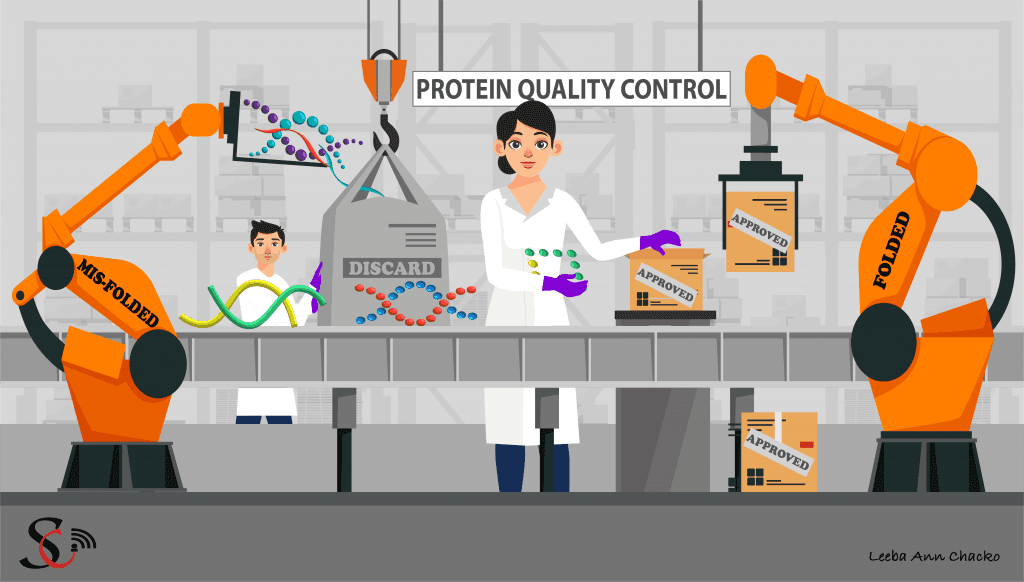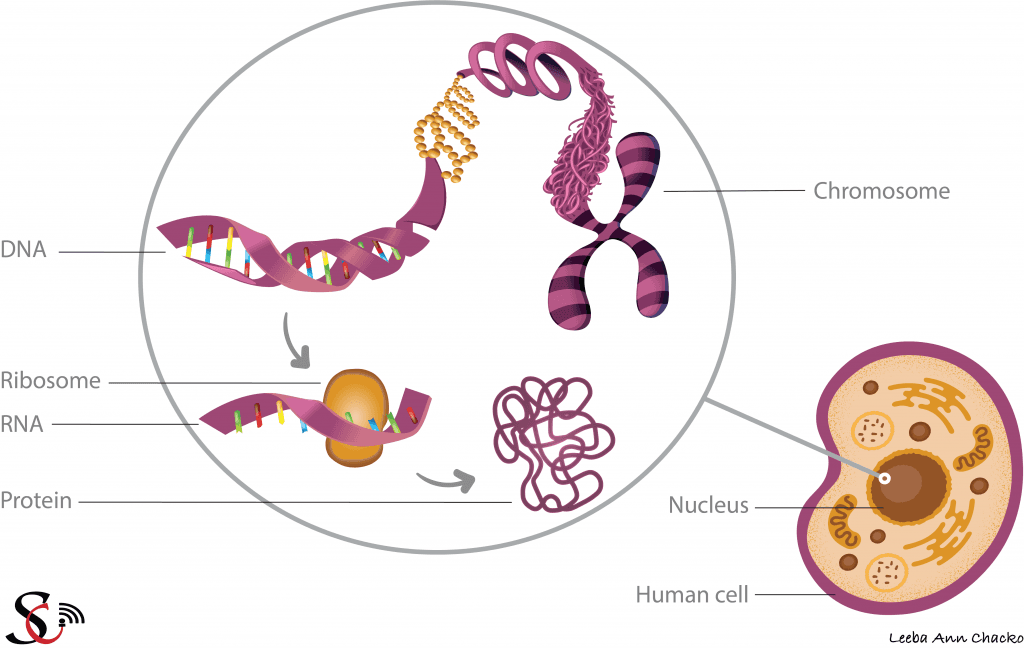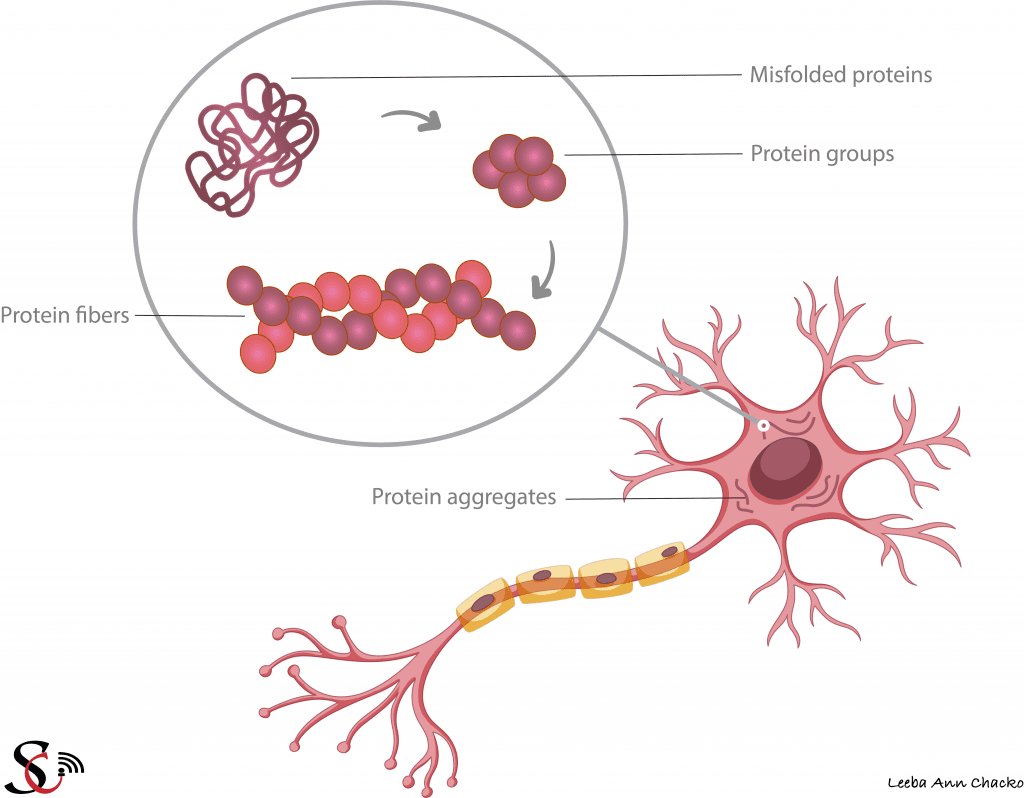
Joel P Joseph
In the previous article of this series, we had seen how incorrectly folded proteins can form clumps and degenerate neurons. In this article, we shall look at how and why this happens.
Protein synthesis and quality control: A flashback

Protein quality control: Segregation of folded and misfolded proteins.
In most organisms, including humans, the deoxyribonucleic acid (DNA) is the genetic material of the cell. This means that the DNA contains a code, which is relayed by the ribonucleic acid (RNA), and finally decoded by tiny machines called ribosomes to produce proteins. In other words, the message on the DNA is interpreted through the RNA to finally make proteins. These proteins perform different functions in the cell, from helping in digesting the food we eat and transporting the nutrients therein to protecting the body against invading bacteria and viruses. Thereby, they control the cell and, in turn, the whole organism.

The central dogma of molecular biology: The nucleus of a cell consists of DNA which contains instructions for making proteins.
You could think of the DNA as the message, the RNA as the messenger who carries the message, and proteins as workers who work on the ground. Just as workers get retired after their service, proteins get degraded once they have performed their function. If a worker misbehaves or does not perform their duty correctly, they can be terminated from duty. Likewise, if a protein is unfolded or misfolded, it is normally degraded in the cell.
The function of a protein depends on its shape, and its shape depends on how it folds. If it is unfolded or misfolded, it cannot perform its function, leading to its degradation. This mode of functioning is true for all the cells of the human body, including the neurons.
The knots: aggregates of misfolded proteins
Misfolded or unfolded proteins form clumps in neurons, called ‘protein aggregates’. This can be triggered by genetic factors, biological factors like bacteria and viruses, the environment around us, or our diet. When protein aggregates accumulate beyond a limit, they become toxic, and can progressively cause loss of neurons. Scientists have found protein aggregates to be one of the major culprits in neurodegenerative diseases. However, they are still trying to understand how, why and where protein aggregates form in different neurodegenerative diseases.

Misfolded protein aggregates within neurons are hallmarks of neurodegenerative diseases like Parkinson’s disease, Alzheimer’s disease and Huntington’s disease.
Scientists have established that specific proteins misfold and form aggregates in specific kinds of neurodegenerative diseases. In Parkinson’s disease (PD), a protein called ‘alpha-synuclein’ is misfolded and forms aggregates in the neurons. When misfolded alpha-synuclein aggregate beyond a limit, they form structures called Lewy bodies. Lewy bodies form the hallmark of PD. While the aggregation of proteins called ‘Tau-beta-amyloid proteins’ leads to Alzheimer’s disease, Huntington’s disease is caused by the aggregation of misfolded ‘Huntingtin protein’.
The structures containing aggregates of misfolded proteins are generally called inclusion bodies. Inclusion bodies are much like multiple knots formed in a wire, causing disruption in the message being carried.
Summary
To sum up, proteins synthesized in a cell have a specific structure and function. When the function of the protein has been carried out, the protein is degraded by different mechanisms in the cell. Misfolded and unfolded proteins are also degraded by these mechanisms. But a failure in these mechanisms in neurons can cause misfolded proteins to accumulate. When these misfolded proteins aggregate beyond a certain limit, they can form inclusion bodies — something like multiple knots in a wire — and can cause neurodegeneration.
In the following articles, we shall learn about some of these neurodegenerative diseases in greater detail.
This article is a part of the series on Neurodegeneration. Find the rest of the articles from this series here.
Illustrator: Leeba Ann Chacko
Edited by: Debdutta Paul





